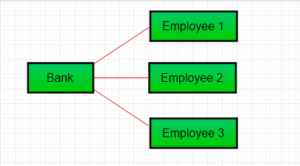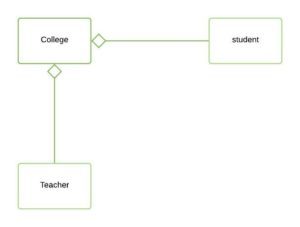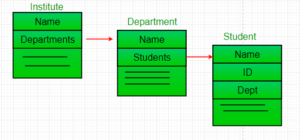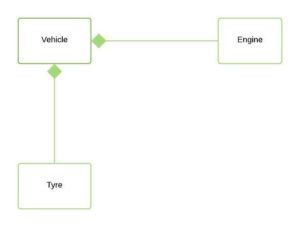
Association
Association is relation between two separate classes which establishes through their Objects. Association can be one-to-one, one-to-many, many-to-one, many-to-many.
In Object-Oriented programming, an Object communicates to other Object to use functionality and services provided by that object. Composition and Aggregation are the two forms of association.
// Java program to illustrate the
// concept of Association
import java.io.*;
// class bank
class Bank
{
private String name;
// bank name
Bank(String name)
{
this.name = name;
}
public String getBankName()
{
return this.name;
}
}
// employee class
class Employee
{
private String name;
// employee name
Employee(String name)
{
this.name = name;
}
public String getEmployeeName()
{
return this.name;
}
}
// Association between both the
// classes in main method
class Association
{
public static void main (String[] args)
{
Bank bank = new Bank("BoB");
Employee emp = new Employee("Rishabh");
System.out.println(emp.getEmployeeName() +
" is employee of " + bank.getBankName());
}
}
Output:
Rishabh is employee of BoB
In above example two separate classes Bank and Employee are associated through their Objects. Bank can have many employees, So it is a one-to-many relationship.


Aggregation
It is a special form of Association where:
- It represents Has-A relationship.
- It is a unidirectional association i.e. a one way relationship. For example, department can have students but vice versa is not possible and thus unidirectional in nature.
- In Aggregation, both the entries can survive individually which means ending one entity will not effect the other entity
// Java program to illustrate
//the concept of Aggregation.
import java.io.*;
import java.util.*;
// student class
class Student
{
String name;
int id ;
String dept;
Student(String name, int id, String dept)
{
this.name = name;
this.id = id;
this.dept = dept;
}
}
/* Department class contains list of student
Objects. It is associated with student
class through its Object(s). */
class Department
{
String name;
private List<Student> students;
Department(String name, List<Student> students)
{
this.name = name;
this.students = students;
}
public List<Student> getStudents()
{
return students;
}
}
/* Institute class contains list of Department
Objects. It is asoociated with Department
class through its Object(s).*/
class Institute
{
String instituteName;
private List<Department> departments;
Institute(String instituteName, List<Department> departments)
{
this.instituteName = instituteName;
this.departments = departments;
}
// count total students of all departments
// in a given institute
public int getTotalStudentsInInstitute()
{
int noOfStudents = 0;
List<Student> students;
for(Department dept : departments)
{
students = dept.getStudents();
for(Student s : students)
{
noOfStudents++;
}
}
return noOfStudents;
}
}
// main method
class Prutor
{
public static void main (String[] args)
{
Student s1 = new Student("Nia", 3, "CSE");
Student s2 = new Student("Rishabh", 2, "CSE");
Student s3 = new Student("Vibha", 1, "EE");
Student s4 = new Student("Dinesh", 2, "EE");
// making a List of
// CSE Students.
List <Student> cse_students = new ArrayList<Student>();
cse_students.add(s1);
cse_students.add(s2);
// making a List of
// EE Students
List <Student> ee_students = new ArrayList<Student>();
ee_students.add(s3);
ee_students.add(s4);
Department CSE = new Department("CSE", cse_students);
Department EE = new Department("EE", ee_students);
List <Department> departments = new ArrayList<Department>();
departments.add(CSE);
departments.add(EE);
// creating an instance of Institute.
Institute institute = new Institute("XYZ", departments);
System.out.print("Total students in institute: ");
System.out.print(institute.getTotalStudentsInInstitute());
}
}
Output:
Total students in institute: 4
In this example, there is an Institute which has no. of departments like CSE, EE. Every department has no. of students. So, we make a Institute class which has a reference to Object or no. of Objects (i.e. List of Objects) of the Department class. That means Institute class is associated with Department class through its Object(s). And Department class has also a reference to Object or Objects (i.e. List of Objects) of Student class means it is associated with Student class through its Object(s).
It represents a Has-A relationship.

When do we use Aggregation ??
Code reuse is best achieved by aggregation.
Composition

Composition is a restricted form of Aggregation in which two entities are highly dependent on each other.
- It represents part-of relationship.
- In composition, both the entities are dependent on each other.
- When there is a composition between two entities, the composed object cannot exist without the other entity.
Lets take example of Library.
// Java program to illustrate
// the concept of Composition
import java.io.*;
import java.util.*;
// class book
class Book
{
public String title;
public String author;
Book(String title, String author)
{
this.title = title;
this.author = author;
}
}
// Libary class contains
// list of books.
class Library
{
// reference to refer to list of books.
private final List<Book> books;
Library (List<Book> books)
{
this.books = books;
}
public List<Book> getTotalBooksInLibrary(){
return books;
}
}
// main method
class Prutor
{
public static void main (String[] args)
{
// Creating the Objects of Book class.
Book b1 = new Book("EffectiveJ Java", "Joshua Bloch");
Book b2 = new Book("Thinking in Java", "Bruce Eckel");
Book b3 = new Book("Java: The Complete Reference", "Herbert Schildt");
// Creating the list which contains the
// no. of books.
List<Book> books = new ArrayList<Book>();
books.add(b1);
books.add(b2);
books.add(b3);
Library library = new Library(books);
List<Book> bks = library.getTotalBooksInLibrary();
for(Book bk : bks){
System.out.println("Title : " + bk.title + " and "
+" Author : " + bk.author);
}
}
}
Output
Title : EffectiveJ Java and Author : Joshua Bloch
Title : Thinking in Java and Author : Bruce Eckel
Title : Java: The Complete Reference and Author : Herbert Schildt
In above example a library can have no. of books on same or different subjects. So, If Library gets destroyed then All books within that particular library will be destroyed. i.e. book can not exist without library. That’s why it is composition.
Aggregation vs Composition
- Dependency: Aggregation implies a relationship where the child can exist independently of the parent. For example, Bank and Employee, delete the Bank and the Employee still exist. whereas Composition implies a relationship where the child cannot exist independent of the parent. Example: Human and heart, heart don’t exist separate to a Human
- Type of Relationship: Aggregation relation is “has-a” and composition is “part-of” relation.
- Type of association: Composition is a strong Association whereas Aggregation is a weak Association.
// Java program to illustrate the
// difference between Aggregation
// Composition.
import java.io.*;
// Engine class which will
// be used by car. so 'Car'
// class will have a field
// of Engine type.
class Engine
{
// starting an engine.
public void work()
{
System.out.println("Engine of car has been started ");
}
}
// Engine class
final class Car
{
// For a car to move,
// it need to have a engine.
private final Engine engine; // Composition
//private Engine engine; // Aggregation
Car(Engine engine)
{
this.engine = engine;
}
// car start moving by starting engine
public void move()
{
//if(engine != null)
{
engine.work();
System.out.println("Car is moving ");
}
}
}
class Prutor
{
public static void main (String[] args)
{
// making an engine by creating
// an instance of Engine class.
Engine engine = new Engine();
// Making a car with engine.
// so we are passing a engine
// instance as an argument while
// creating instace of Car.
Car car = new Car(engine);
car.move();
}
}
Output:
Engine of car has been started
Car is moving
